

Compact Muon Solenoid
LHC, CERN
| CMS-PAS-EXO-16-045 | ||
| Search for heavy neutrinos and W bosons with right handed couplings in proton-proton collisions at $\sqrt{s} = $ 13 TeV | ||
| CMS Collaboration | ||
| May 2017 | ||
| Abstract: A search for heavy right handed neutrinos $\mathrm{N}_\ell$ ($\ell = \mathrm{e}, \mu$), and right handed $W_R$ bosons, performed by the CMS experiment is summarized here. Using the 2.6 fb$^{-1}$ of integrated luminosity recorded by the CMS experiment in 2015 at a center-of-mass energy of 13 TeV, this search seeks evidence of $W_R$ bosons and $\mathrm{N}_\ell$ neutrinos in events with two leptons and two jets. The data do not significantly exceed expected backgrounds, and are consistent with expected results given uncertainties. For Standard Model extensions with strict left-right symmetry, and assuming only one $\mathrm{N}_\ell$ flavor contributes significantly to the $W_R$ decay width, mass limits are set in the two-dimensional $(M_{W_R}, M_{\mathrm{N}_\ell})$ plane at the ninety five percent confidence level. The limits extend to $M_{W_R}$ of 3.3 TeV (3.5 TeV) in the electron (muon) channel, and span a wide range of $M_{\mathrm{N}_\ell}$ values below $M_{W_R}$. | ||
| Links: CDS record (PDF) ; inSPIRE record ; CADI line (restricted) ; | ||
| Figures & Tables | Summary | Additional Figures | References | CMS Publications |
|---|
| Figures | |

png pdf |
Figure 1:
Feynman diagram for the production of a ${W_R}$ boson and its decay to two charged leptons and two quarks through a heavy neutrino. |
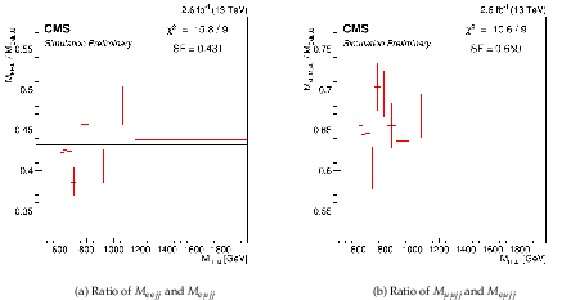
png pdf |
Figure 2:
Bin-by-bin ratio of ${M_{\ell \ell j j}}$ distribution and ${M_{\mathrm{ e } \mu j j}}$ from top quark background simulations, where $\ell $ is an electron (left) or a muon (right). |

png |
Figure 2-a:
Bin-by-bin ratio of ${M_{\ell \ell j j}}$ distribution and ${M_{\mathrm{ e } \mu j j}}$ from top quark background simulations, where $\ell $ is an electron. |
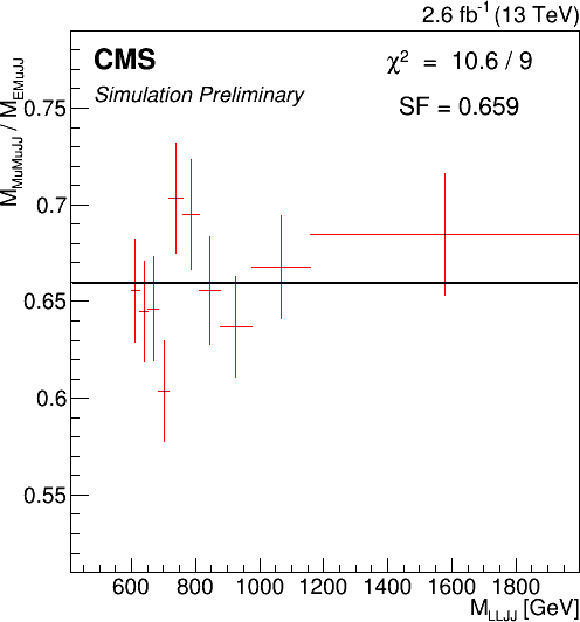
png |
Figure 2-b:
Bin-by-bin ratio of ${M_{\ell \ell j j}}$ distribution and ${M_{\mathrm{ e } \mu j j}}$ from top quark background simulations, where $\ell $ is a muon. |

png pdf |
Figure 3:
${M_{\ell \ell j j}}$ in the electron and muon channel signal regions. For the ${W_R}$ signal shown, $M_{ {\mathrm {N}_{\ell }} } = \frac {1}{2} {M_{\mathrm{ W } _{\mathrm {R}}}} $. Both plots use 200 GeV wide bins from 600 to 1800 GeV, then one bin spans 1800 to 2200 GeV, and finally the last bin includes all events above 2200 GeV. In addition, the bin contents are divided by the bin widths. |
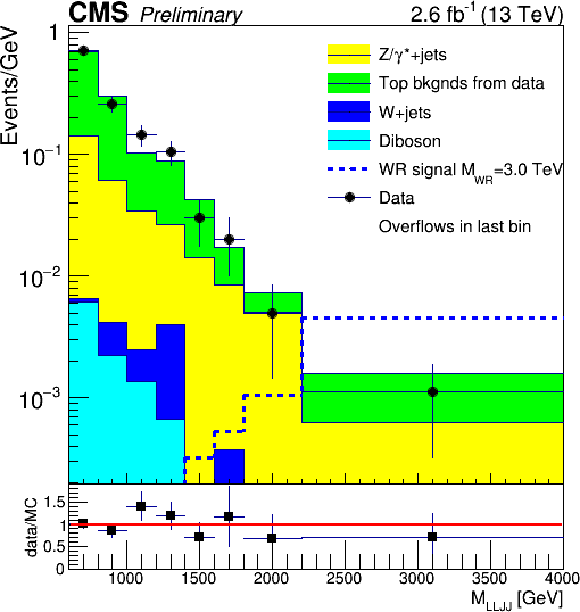
png |
Figure 3-a:
${M_{\ell \ell j j}}$ in the electron channel signal region. For the ${W_R}$ signal shown, $M_{ {\mathrm {N}_{\ell }} } = \frac {1}{2} {M_{\mathrm{ W } _{\mathrm {R}}}} $. The plot uses 200 GeV wide bins from 600 to 1800 GeV, then one bin spans 1800 to 2200 GeV, and finally the last bin includes all events above 2200 GeV. In addition, the bin contents are divided by the bin widths. |
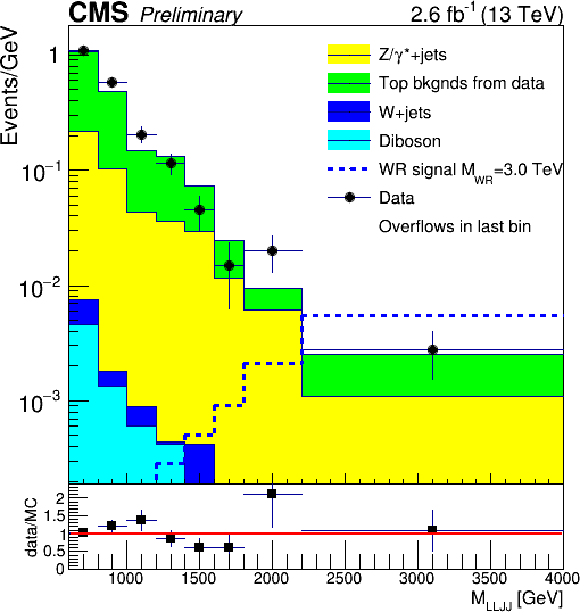
png |
Figure 3-b:
${M_{\ell \ell j j}}$ in the muon channel signal region. For the ${W_R}$ signal shown, $M_{ {\mathrm {N}_{\ell }} } = \frac {1}{2} {M_{\mathrm{ W } _{\mathrm {R}}}} $. The plot uses 200 GeV wide bins from 600 to 1800 GeV, then one bin spans 1800 to 2200 GeV, and finally the last bin includes all events above 2200 GeV. In addition, the bin contents are divided by the bin widths. |
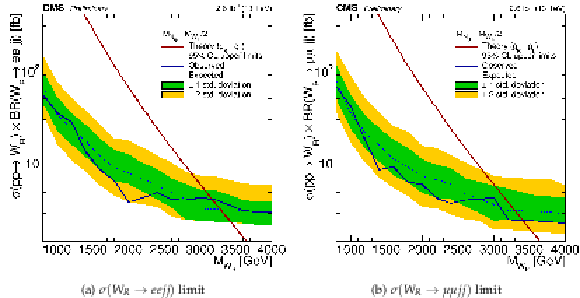
png pdf |
Figure 4:
${W_R}$ cross section limits for $M_{ {\mathrm {N}_{\ell }} } = \frac {1}{2} {M_{\mathrm{ W } _{\mathrm {R}}}} $. |
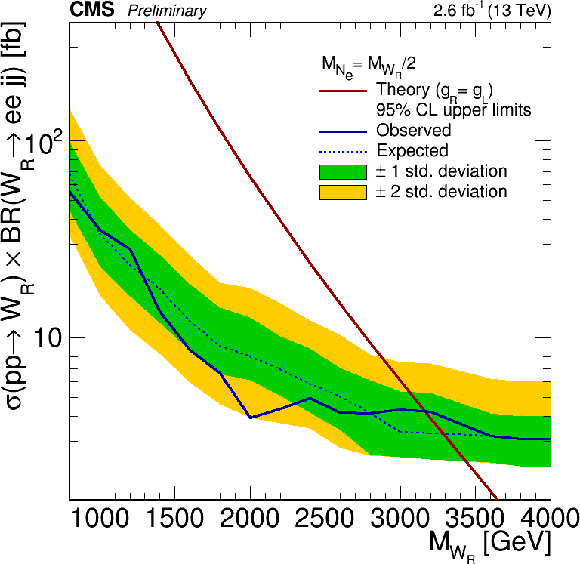
png |
Figure 4-a:
${W_R}$ cross section limits for $M_{ {\mathrm {N}_{\ell }} } = \frac {1}{2} {M_{\mathrm{ W } _{\mathrm {R}}}} $. Electron channel. |

png |
Figure 4-b:
${W_R}$ cross section limits for $M_{ {\mathrm {N}_{\ell }} } = \frac {1}{2} {M_{\mathrm{ W } _{\mathrm {R}}}} $. Muon channel. |
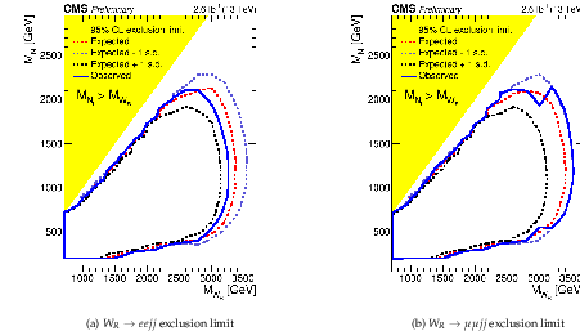
png pdf |
Figure 5:
95% confidence level exclusion in the $( {M_{\mathrm{ W } _{\mathrm {R}}}} , M_{ {\mathrm {N}_{\ell }} })$ plane for $ {W_R} \to eejj$ (left) and $ {W_R} \to \mu \mu jj$ (right). |
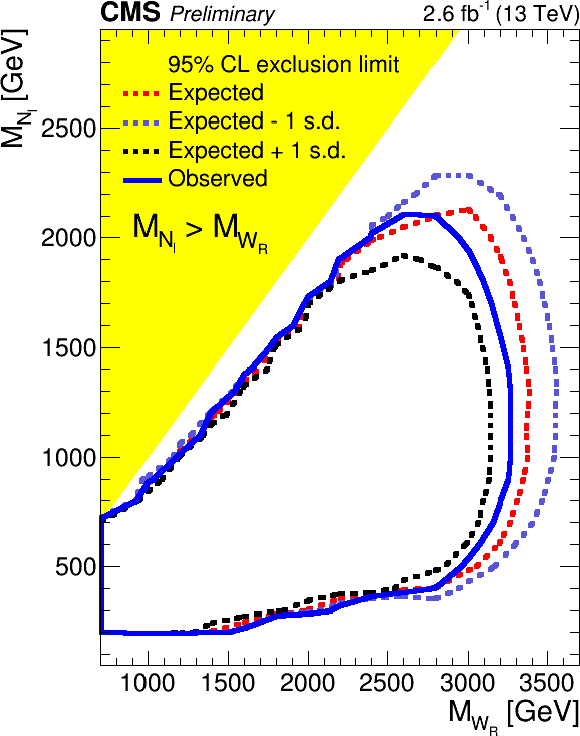
png |
Figure 5-a:
95% confidence level exclusion in the $( {M_{\mathrm{ W } _{\mathrm {R}}}} , M_{ {\mathrm {N}_{\ell }} })$ plane for $ {W_R} \to eejj$. |
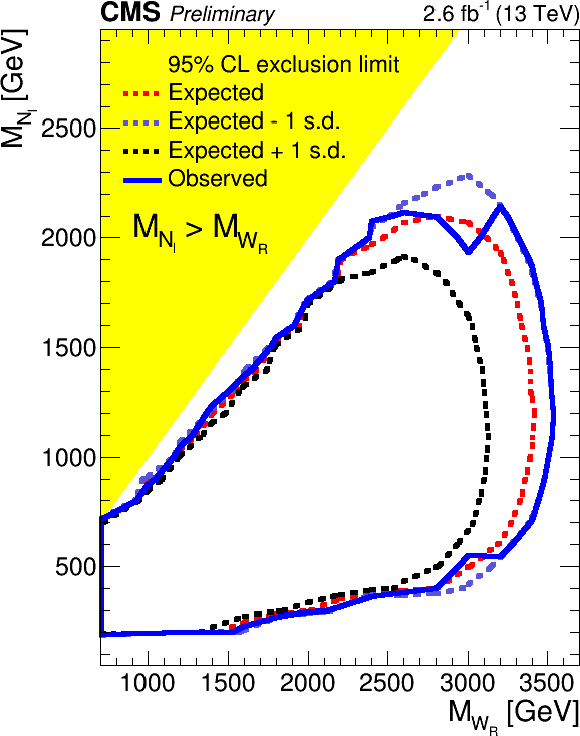
png |
Figure 5-b:
95% confidence level exclusion in the $( {M_{\mathrm{ W } _{\mathrm {R}}}} , M_{ {\mathrm {N}_{\ell }} })$ plane for $ {W_R} \to \mu \mu jj$. |
| Tables | |
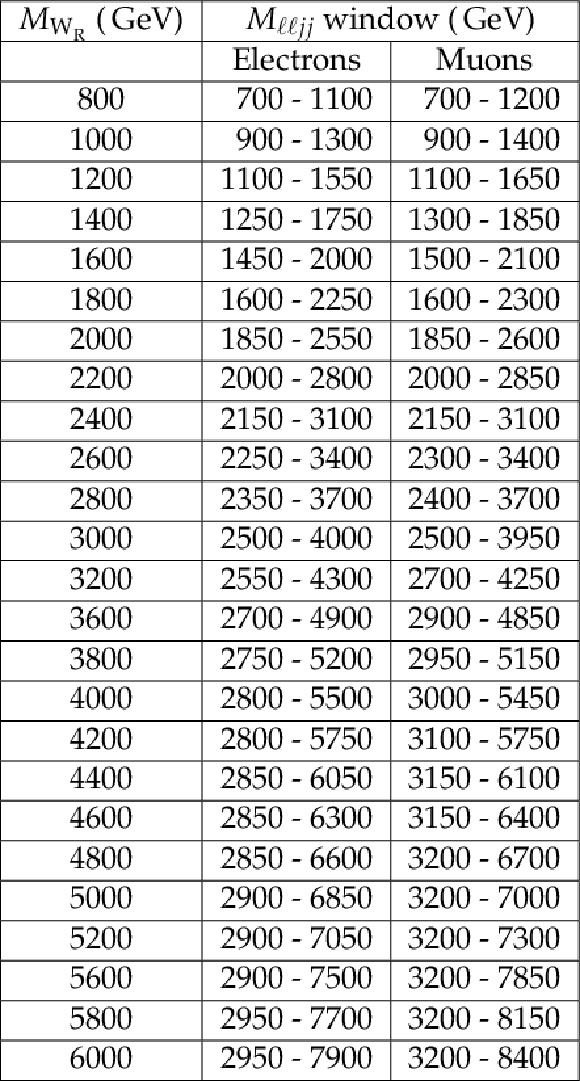
png pdf |
Table 1:
${M_{\ell \ell j j}}$ windows that minimize the expected ${W_R}$ cross section limit at each ${M_{\mathrm{ W } _{\mathrm {R}}}}$ point. |
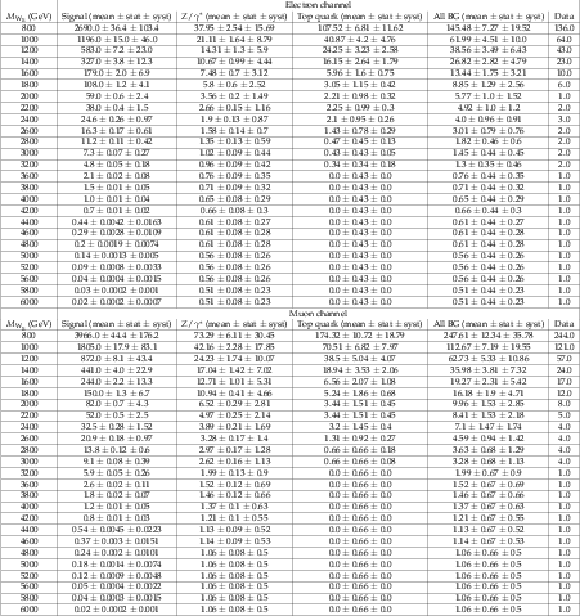
png pdf |
Table 2:
For ${W_R}$ mass hypotheses with $M_{ {\mathrm {N}_{\ell }} } = \frac {1}{2} {M_{\mathrm{ W } _{\mathrm {R}}}} $, these are the mean number of expected ${W_R}$ signal and background events, their statistical and systematic errors, and the number of observed events in data. All errors are given in number of events, and refer to the mean number of expected events. The analysis was run 3200 times to estimate the errors listed here, and the systematic errors from jet and lepton energy scale uncertainties are added in quadrature with systematic errors from luminosity, pileup and background normalization uncertainty. For the $ {M_{\mathrm{ W } _{\mathrm {R}}}} = $ 2.6 TeV hypothesis, the electron channel top quark background estimate is higher than the muon channel because the electron channel ${M_{\mathrm{ W } _{\mathrm {R}}}}$ window extends lower in ${M_{\ell \ell j j}}$ (see Table {tab:masscuts}). In the $e\mu jj$ data used to estimate the top quark background, there is a deficit of events in the region 1.8 TeV $ < {M_{\mathrm{ e } \mu j j}} < $ 2.1 TeV that, in both channels, results in little change in the top quark background going from the $ {M_{\mathrm{ W } _{\mathrm {R}}}} = $ 2.0 TeV to the $ {M_{\mathrm{ W } _{\mathrm {R}}}} = $ 2.2 TeV bin. |
| Summary |
| A search for right-handed bosons ($W_R$) and heavy right-handed neutrinos ($\mathrm{N}_\ell$) in the left-right symmetric extension of the standard model has been presented. $W_R$ boson production is excluded at the 95% confidence level up to $ M_{W_R} < $ 3.5 (3.3) TeV in the muon (electron) channel. These results are consistent with expectations based on simulations of SM processes, and extend the mass limits in the muon (electron) channel 400 GeV (400 GeV) higher in $M_{W_R}$, and 150 GeV (300 GeV) higher in $M_{\mathrm{N}_ell}$ relative to the Run I limits. |
| Additional Figures | |

png pdf |
Additional Figure 1:
Data compared to the Run I excess plus expected backgrounds in the electron channel $M_{LLJJ}$ distribution. For the ${W_R}$ signal shown, $M_{N_{l}} = \frac {1}{2} M_{W_{R}}$. The bins are 200 GeV wide. |
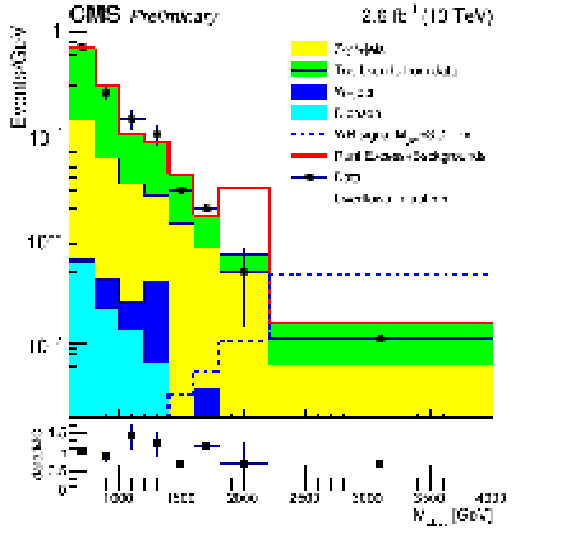
png pdf |
Additional Figure 2:
Data compared to the Run I excess plus expected backgrounds in the electron channel $M_{LLJJ}$ distribution. For the ${W_R}$ signal shown, $M_{N_{l}} = \frac {1}{2} M_{W_{R}}$. The plot uses 200 GeV wide bins from 600 to 1800 GeV, then one bin spans 1800 to 2200 GeV, and finally the last bin includes all events above 2200 GeV. All bin contents are divided by the bin widths. |
| The results from 2015 data in the electron channel are compared to expected backgrounds plus the Run I electron channel excess in Additional Fig. 1 and Additional Fig. 2. The Run I excess normalization is rescaled to account for differences in integrated luminosity and $W_{R}$ cross section between 2012 and 2015, and its shape is modeled using a Gaussian. Since the Run I excess spanned 1.8 $ < M_{EEJJ} < $ 2.2 TeV, the mean of the Gaussian representing the excess was set to 2.0 TeV. Furthermore, the standard deviation of the Gaussian $\sigma_{gaus}$ was chosen so that +3$\sigma_{gaus}$ (-3$\sigma_{gaus}$) away from the mean equaled 2.2 (1.8) |
| References | ||||
| 1 | S. L. Glashow | Partial-symmetries of weak interactions | Nucl. Phys. 22 (1961) 579 | |
| 2 | S. Weinberg | A Model of Leptons | PRL 19 (1967) 1264 | |
| 3 | A. Salam | Weak and electromagnetic interactions | in Elementary particle physics: relativistic groups and analyticity, N. Svartholm, ed., p. 367 Almqvist \& Wiskell, 1968 Proceedings of the eighth Nobel symposium | |
| 4 | J. C. Pati and A. Salam | Lepton number as the fourth "color" | PRD 10 (1974) 275 | |
| 5 | R. N. Mohapatra and J. C. Pati | A Natural Left-Right Symmetry | PRD 11 (1975) 2558 | |
| 6 | G. Senjanovi\'c and R. N. Mohapatra | Exact left-right symmetry and spontaneous violation of parity | PRD 12 (1975) 1502 | |
| 7 | W.-Y. Keung and G. Senjanovi\'c | Majorana Neutrinos and the Production of the Right-Handed Charged Gauge Boson | PRL 50 (1983) 1427 | |
| 8 | W. M. Alberico and S. M. Bilenky | Neutrino Oscillations, Masses and Mixing | Phys. Part. Nucl. 35 (2003) 297 | hep-ph/0306239 |
| 9 | C. Giunti and M. Laveder | Neutrino mixing | in Developments in Quantum Physics, F. Columbus and V. Krasnoholovets, eds Nova Science Publishers, Inc. | hep-ph/0310238 |
| 10 | Particle Data Group Collaboration | Review of Particle Physics | CPC 40 (2016), no. 10, 100001 | |
| 11 | R. N. Mohapatra and G. Senjanovi\'c | Neutrino Mass and Spontaneous Parity Nonconservation | PRL 44 (1980) 912 | |
| 12 | M. Gell-Mann, P. Ramond, and R. Slansky | Complex Spinors and Unified Theories | in Supergravity, P. van Nieuwenhuizen and D. Z. Freedman, eds North Holland Publishing Co. | 1306.4669 |
| 13 | CMS Collaboration | Search for heavy neutrinos or third-generation leptoquarks in final states with two hadronically decaying tau leptons and two jets in proton-proton collisions at $ \sqrt{s} $ = 13 TeV | JHEP 03 (2017) 077 | CMS-EXO-16-016 1612.01190 |
| 14 | CMS Collaboration | Search for the third-generation scalar leptoquarks and heavy right-handed neutrinos in $ \tau_{l}\tau_{h} jj $ final states in pp collisions at 13 TeV | CDS | |
| 15 | CMS Collaboration | Search for heavy composite Majorana neutrinos produced in association with a lepton and decaying into a same-flavour lepton plus two quarks at $ \sqrt{s} $ = 13 TeV with the CMS detector | CDS | |
| 16 | CMS Collaboration | Search for heavy neutrinos and $ \mathrm {W} $ bosons with right-handed couplings in proton-proton collisions at $ \sqrt{s} = $ 8 TeV | EPJC74 (2014), no. 11 | CMS-EXO-13-008 1407.3683 |
| 17 | E. Nardi, E. Roulet, and D. Tommasini | New Neutral Gauge Bosons and New Heavy Fermions in the Light of the New LEP Data | PLB 344 (1995) 225 | hep-ph/9409310 |
| 18 | G. Beall, M. Bander, and A. Soni | Constraint on the Mass Scale of a Left-Right-Symmetric Electroweak Theory from the KL-KS Mass Difference | PRL 48 (1982) 848 | |
| 19 | A. Maiezza, M. Nemev\vsek, F. Nesti, and G. Senjanovi\'c | Left-right symmetry at LHC | PRD 82 (2010) 055022 | 1005.5160 |
| 20 | CMS Collaboration | The CMS experiment at the CERN LHC | JINST 03 (2008) S08004 | CMS-00-001 |
| 21 | T. Sj\"ostrand, S. Mrenna, and P. Skands | PYTHIA 6.4 Physics and Manual | JHEP 05 (2006) 026 | hep-ph/0603175 |
| 22 | NNPDF Collaboration | Unbiased global determination of parton distributions and their uncertainties at NNLO and at LO | Nucl. Phys. B 855 (2012) 153 | 1107.2652 |
| 23 | S. Alioli et al. | A general framework for implementing NLO calculations in shower Monte Carlo programs: the POWHEG BOX | JHEP 06 (2010) 043 | 1002.2581 |
| 24 | E. Re | Single-top Wt-channel production matched with parton showers using the POWHEG method | EPJC 71 (2010) 1547 | 1009.2450 |
| 25 | S. Alioli, P. Nason, C. Oleari, and E. Re | NLO single-top production matched with shower in POWHEG: s- and t-channel contributions | JHEP 09 (2009) 111 | 0907.4076 |
| 26 | J. Alwall et al. | MadGraph 5: Going Beyond | JHEP 06 (2011) 128 | 1106.0522 |
| 27 | CMS Collaboration | Event generator tunes obtained from underlying event and multiparton scattering measurements | EPJC 76 (2016) 155 | CMS-GEN-14-001 1512.00815 |
| 28 | GEANT4 Collaboration | GEANT4 -- a simulation toolkit | NIMA 506 (2003) 250 | |
| 29 | CMS Collaboration | Search for a Narrow Resonance Produced in 13 TeV pp Collisions Decaying to Electron Pair or Muon Pair Final States | CDS | |
| 30 | M. Cacciari and G. P. Salam | Pileup subtraction using jet areas | PLB 659 (2008) 119 | 0707.1378 |
| 31 | CMS Collaboration | Commissioning of the Particle-Flow Event Reconstruction with the first LHC collisions recorded in the CMS detector | CDS | |
| 32 | CMS Collaboration | Particle-Flow Event Reconstruction in CMS and Performance for Jets, Taus, and MET | CDS | |
| 33 | M. Cacciari, G. P. Salam, and G. Soyez | The anti-$ k_{t} $ jet clustering algorithm | JHEP 04 (2008) 063 | 0802.1189 |
| 34 | M. Cacciari, G. P. Salam, and G. Soyez | The Catchment Area of Jets | JHEP 04 (2008) 005 | 0802.1188 |
| 35 | CMS Collaboration | Study of Pileup Removal Algorithms for Jets | CMS-PAS-JME-14-001 | CMS-PAS-JME-14-001 |
| 36 | CMS Collaboration | Jet Performance in pp Collisions at $ \sqrt{s} = 7 $ TeV | CDS | |
| 37 | CMS Collaboration | Determination of Jet Energy Calibration and Transverse Momentum Resolution in CMS | JINST 6 (2011) 11002 | CMS-JME-10-011 1107.4277 |

|
Compact Muon Solenoid LHC, CERN |

|

|

|

|

|

|